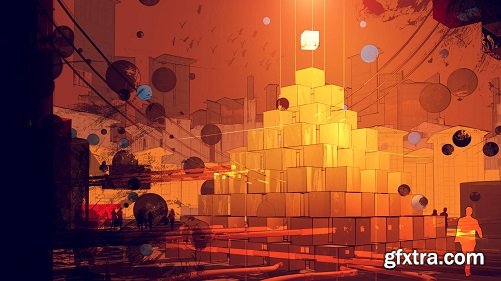Crypto Art: Create a Dystopian City Using Traditional Painting Techniques and Cinema 4D
https://www.skillshare.com/classes/Crypto-Art-Create-a-Dystopian-City-Using-Traditional-Painting-Techniques-and-Cinema-4D/13048200
Welcome to this course on Crypto Art: Creating a Dystopian City Using Traditional Painting Techniques and Cinema 4D.
In this series of lessons we will cover a lot to give you a solid understanding of the creative and technical steps of combining traditional and 3D illustrative techniques. The topics that will be covered include:
01. An overview of the process used to create your own custom-crafted brushstrokes using traditional painting methods.
- Discussion of painting materials and mediums.
- Discussion of negative and positive space when creating the initial brushstrokes with variations.
- Scanning in Adobe Photoshop.
- Curves in Photoshop and applying the adjustments to all the brush scans.
02. Adding the painted brushstrokes to materials in Cinema 4D and applying them to 3D models.
- Establishing a color scheme to use throughout the work.
- Overview of Adobe Color.
- Creating materials in Cinema 4D using the brushstrokes as the basis.
- Creating bump and alpha channels and adjusting the alpha for a cleaner look.
- Reusing the materials to create color variations.
03. 3D Modeling the elements that make up the dystopian city.
- Creating parametric primitives and adjusting the material projection using the texture tool.
- Creation of random spheres using the MoGraph Cloner, effectors and fields.
- 3D modeling the buildings using simple parametric primitives, the make editable function, additional modeling tools and the use the MoGraph Cloner.
- Creating the pyramid using a MoGraph Cloner, Cube and Volume Effector and adjusting the overall shape.
- Creating the details of wires, pipes and coils using Sweep NURBS and cloners.
- Creating the birds using a cissoid spline, rectangle spline and Sweep NURBS. Scattering the birds with MoGraph and random effector.
04. Establishing a solid composition using the rule of thirds and leading the eye to the main focal of the image.
- Render settings and output dimensions.
- Camera settings and using the composition tab’s grid setting.
- Discussion of the rule of thirds.
- Placing the foreground, mid-ground and background elements within the scene for a balanced composition.
- MoGraph selection and hide selection functions.
05. Lighting the Scene.
- The use of the environment tool, creating fog, and adjusting the fog’s color and distance settings.
- Using omni lights and adjusting the color, visible light and shadow settings.
06. Rendering
- Creating compositing tags and object buffers for all the main geometry of the scene.
- Set-up multi-pass layers within the render settings.
- Set-up the Cel Renderer effect and export outlines and edges as separate passes.
- Set-up the Sketch and Toon effect and export as a separate pass.
07. Post-production workflows in Adobe Photoshop.
- Organization of multi-pass layers and channels.
- Compositing cel renders and sketch and toon into the multi-pass file and setting the proper blend modes.
- Layer masks and non-destructive editing of details.
- Painting light effects and using the channels for quick selections.
- Painting radiating light and using the channels for quick selections.
- Quick mask mode, painting details for emphasis and visual impact.
- Repurposing the brush patterns for added detail, composition, grunge and dirt.
- Adding people with a discussion of various free and paid resources for creating entourage.
- Curves adjustments and refining the overall look/feel of the work.
- Painting additional detail using the brush tool.
- Adding glows and highlights to emphasize the main focal of the image.
08. Bonus Lecture
- Tips and tricks for working efficiently.
- Creating custom assets.
- Using Cinema 4D’s content browser to save your creations for use in later projects.
- Repurposing content for future work and variations on a theme.






